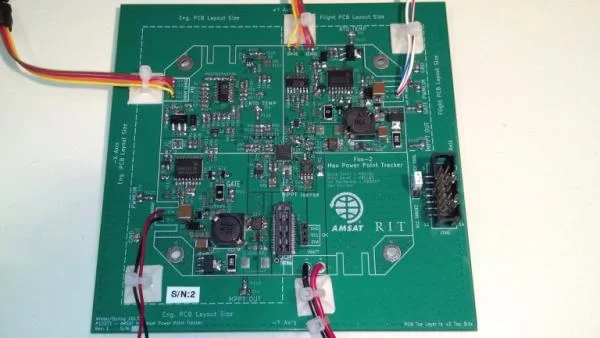Maximum Power Point Tracking
Let’s cover the basics first. A Maximum Power Point Tracker is an intermediate circuit placed between a solar panel and the load being powered. Solar panels produce the maximum amount of power at a specific voltage which varies with light irradiance as well as board temperature. The MPPT interfaces the solar panel with the load in such a way that the conditions for maximum power are always met when needed. In the case of RadFxSat the MPPT is temperature based since most of the change occurs with solar panel temperature and much smaller effects are created by irradiance from the Sun. Read the Fox-1 MPPT Technical Document if you are interested in the details of how the Fox-1 MPPT works.
It All Started at RIT
During the Dayton Ohio Hamfest in May 2012 Anthony Montiero, AA2TX, agreed to sponsor a senior design project for us during the next academic year at the Rochester Institute of Technology. Tony was the Vice President of AMSAT engineering at the time. He wanted us to design a new Maximum Power Point Tracker that could be used by AMSAT on future missions which were flying higher power radios and larger scientific payloads. The original intent was to fly this MPPT on a 3U cubesat named Fox-2.
The senior design team consisted of just four students: Ian Mackenzie (KB3OCF), Dan Corriero, Brenton Salmi (KB1LQD), and myself (KB1LQC). We had chosen to work together as we were all members of K2GXT, the RIT Amateur Radio Club, and had recently built and launched RITchie-1 (a high altitude balloon) together. We were guided by two Rochester, NY area engineers, Vincent Burolla and Leo Farnand, who had agreed to help us out and were obviously skeptical of the pure amount of work we had signed-up for. However, our team was motivated and ready for the challenge.
P13271: AMSAT Maximum Power Point Tracker
At the time RIT was still on the quarter system which meant that the two quarter Senior Design course only gave us 20 weeks to design, build, and test a working MPPT. Every one of us still had normal coursework and were active members of K2GXT. Great lessons of descoping projects, good communication, and teamwork were tested during this time. I vividly remember being one of the only teams who would put feelings aside in effort to make quick progress. For example, we never perfected our documentation before sending it to our guides. Instead our team wanted their feedback as soon as possible if were unsure about something. We knew we could do it but we also knew that we were learning and acknowledging that let us focus on the goal of getting an analog MPPT designed, built and tested in such a short time-frame.
Read More: AMSAT MPPT

